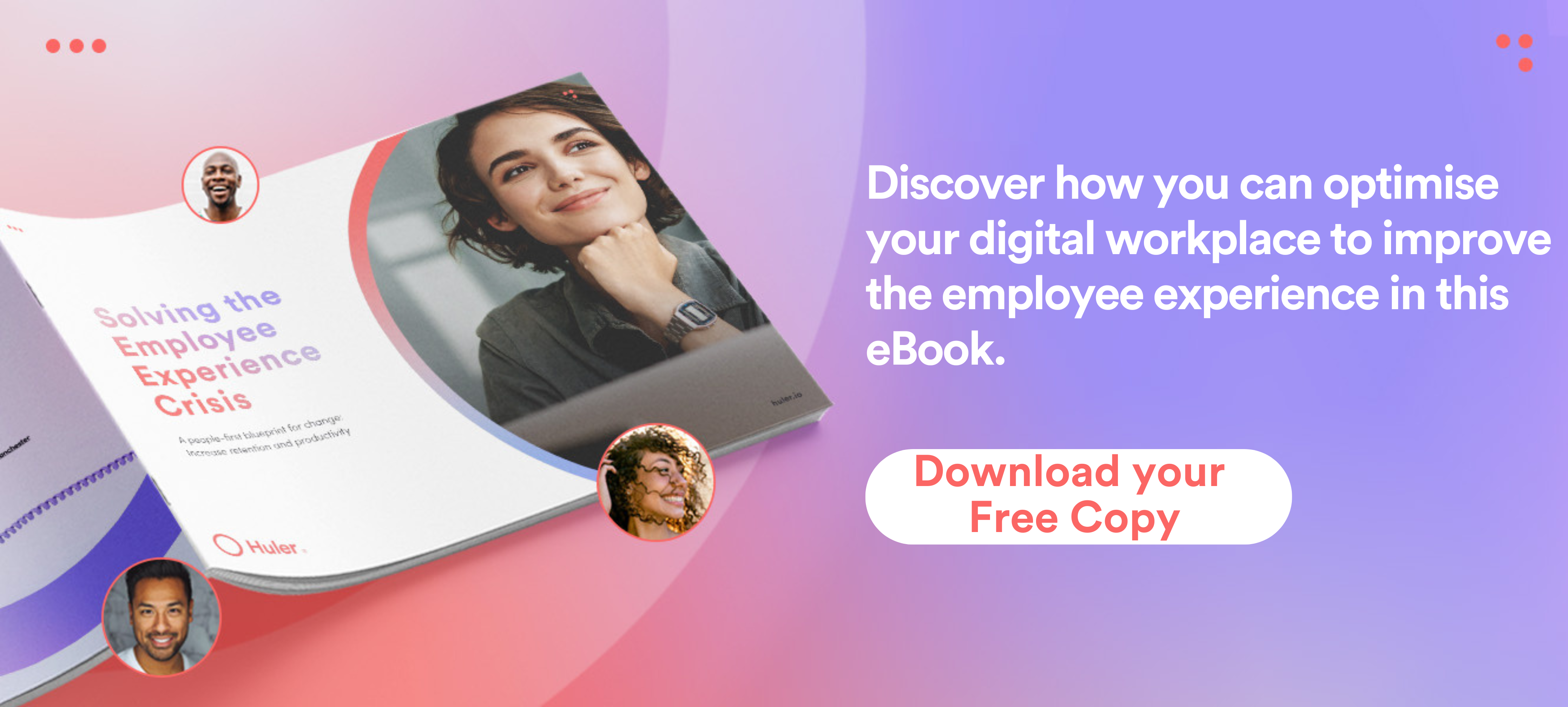The way we work is changing. In recent years, technology has given us more freedom over where, how and when we can work. Perhaps more importantly, our collective work mindset has shifted, forced in no small part by the unprecedented events of 2020. Now, more than ever, many employees and organisations are embracing the notion that work isn’t necessarily defined by a physical location. Instead, work can happen anywhere with the right tools, culture, leadership and technology frameworks to support it.
The digital workplace is part of this framework. It encompasses all the things’ employees use to get work done, ranging from internal communications, HR systems, and collaboration tools to document management, instant messaging apps and social networks.
Digital Workplace Guide
- Digital Workplace Introduction and Definition
- Common Digital Workplace Platform Features
- Why Do Businesses Need A Digital Workplace?
- Digital Transformation and Employee Experience
- Frequently Asked Questions
- Digital Workplaces & The Future Of Work
Introduction
While digitisation in the workplace was happening long before 2020, there is no doubt that COVID-19 accelerated the process. Recent data shows that business digital adoption leaped forward by five years in a matter of eight weeks back in May 2020 and shows no signs of slowing down. The challenge now comes for businesses to implement an integrated technology framework, or digital workplace platform, to realise the true potential of that rapid unprecedented uptake.
Digital workplaces comprise of all the tools an employee uses to get work done, including instant messaging apps, video conferencing tools, social media, and workflows. Typically, all of these tools can be accessed from anywhere, providing the employee has an internet-enabled device.
Pretty much every organisation has some kind of formal or informal digital workplace. At its simplest it’s just a collection of tools and content that enable employees to do their jobs. However, following such rapid change and adoption of new tech, businesses now need to implement integrated technology frameworks, such as digital workplace platforms, in order to maximise the potential of all of those disparate tools and systems.
What Is A Digital Workplace?
A digital workplace is a secure cloud-based platform that helps businesses empower and enable their workforce to be productive whether they work remotely, on-site or a mix between the two. These platforms are securely accessible from any device, at any time, anywhere in the world and contain everything employees need to do their jobs effectively such as applications, data, content, files, tools, software and documents.
Of course, the things employees need vary widely between job roles, departments, organisations and sectors. In terms of Intranet v digital workplace. A digital workplace solution offers a personalised way of bringing everything together in one virtual platform that’s accessible from anywhere, anytime, on any device.
The aim of a digital workplace is to make working from anywhere possible. This is particularly poignant right now as hybrid working models become more popular in response to employee demand and preferences. In order to balance business goals with employee preference, organisations need to find solutions that enable better:
- Communication
- Collaboration
- Project management
- Transparency
- Problem solving
- Automation
- Culture building
A digital workplace is:
- Unified – it brings together everything in one place
- Logical – it makes finding what you need easy through a highly intuitive user interface and powerful search
- Secure – it protects sensitive data and information to the highest industry standards
It empowers employees (whether they are based on-site or remotely) to work more productively, better collaborate with colleagues across a number of different teams, and access they information they need in a matter of seconds rather than minutes.
A digital workplace also makes working from anywhere possible. This is hyper-relevant in the now of work we find ourselves in, as the demand for more remote work opportunities is on the rise and many organisations recognise the benefits of hybrid working.
Digital Workplace Features
Companies are rapidly shifting from hardware-based infrastructure to cloud-based applications. A digital workplace can help these businesses gain a competitive advantage through collaboration on a global scale, flexibility in accessing information from any location and the ability to use the right tools when they need them.
Single Sign On (SSO)
Single Sign On (SSO) rids users the headache of having to remember multiple passwords by letting them just use one set of login credentials to access multiple applications.
In a digital workplace platform, users simply only have to log in once to the platform in order to access everything within it. The biggest benefit of SSO is that users of a digital workplace are able to access everything they need from anywhere without the stress of remembering all of their passwords. As more and more organisations turn to hybrid working models enabling a frictionless employee experience wherever teams work from is a high priority, and digital workplaces aim to address this through features like SSO.
Secure Access To Everything
Digital workplaces give employees full visibility of their projects, tasks, tools, third-party applications, reports and more, regardless of where or when they work. While the prospect of this is exciting, security is a top priority for any business as they look to protect both their own data and that of customers in an ever-widening workplace. Cutting edge digital workplaces enable work from anywhere while making sure that information is stored securely and only accessed by those who have need it and are authorised to use it.
Personalisation
Digital tools used by individuals vary widely from department to department. While some teams use Slack, others use Teams. For project management, developers might use Asana, while content teams may use Monday. With so many disparate systems and technologies in play, finding what you need among the noise can be time-consuming and frustrating. As well as this, not all internal communications and company news is relevant to everyone which can lead to employees neglecting to keep up to date with new information.
Digital workplace platforms offer personalisation that lets employees create their own unique workplaces and populate them with the tools they use everyday and need quick access to. It also makes visible the tools other teams are using to make knowledge sharing and document management easier outside of restricting workplace silos. What’s more, new apps, content, information, news, tools and software can also be rolled out quickly and monitored within the platforms to encourage engagement and adoption.
File Sharing
When teams work remotely or asynchronously, finding information and files can be time consuming, frustrating, and sometimes pretty much impossible. While an employee intranet gives you a repository to house all of that information, a digital workplace platform puts it all in one place and makes it easily searchable and shareable.
If information is housed online in a single unified space, there is no need for employees to make several phone calls or send countless emails and messages to try and find what they need.
Collaboration Tools
Workplace silos result in repeated work, misaligned priorities and missed opportunities for collaboration. This kind of mentality comes about when teams and departments aren’t given the opportunity to work flexibly with each other.
Lack of transparency and restricted access to information can intensify silo mentality. Digital workplace platforms help to eliminate that by making information more readily available, allowing employees to work fluidly together in a frictionless way.
Analytics
Measuring employee engagement and experience has always been tricky. After all, how do you measure a feeling or analyse sentiment when you don’t really know what employees are thinking or doing? This becomes even more difficult in remote and hybrid work models, when employees aren’t physically visible day in, day out.
A digital workplace solution provides this visibility, giving managers and HR teams actionable insights into work patterns, employee sentiment, digital adoption and employee engagement. This data allows organisations to harness the power of their workforce and the technology they are using, providing them with the tools they need to work smarter, collaborate more effectively, conduct focused work and achieve better work-life balance.
AI and Machine Learning
Artificial intelligence and machine learning are rapidly changing our lives both at home and work. As we become more savvy about technology, and the ways in which we can use it to be more productive, we are constantly on the lookout for ways to harness this tech to our benefit. A digital workplace leverages these technological advances to help users work smarter; whether that’s automating or streamlining workflows or powerful search features that surface the right content at the point of need, even if the searcher isn’t sure what they are looking for.
As digital workplaces evolve, it’s likely that artificial intelligence and machine learning will feature more heavily in our day to day. Artificial intelligence, for example, can be used to read data and provide valuable insights. In a digital workplace, AI can be utilised to identify patterns, isolate trends and make predictions in regards to employee productivity, sentiment and digital adoption. Having access to this information is one thing, but having a powerful data analyst on hand who can decipher what data means in a matter of minutes is a gamechanger, especially when it comes to shaping the employee experience and journey.
In a similar vein, machine learning also has the potential to help employees be more efficient and productive, especially when it comes to content discovery. As we’ve established, most employees have to contend with a tsunami of information every single day. A digital workplace can learn the rhythms of a person’s work day and support them in their work with personalised content. This could be work-related, culture based or even wellbeing information and initiatives like mindful moments, and check ins that aim to support the mental health of employees and prevent burnout.

Why Use A Digital Workplace?
The benefits of adopting a digital workplace make these platforms the next logical step in any organisation’s digital transformation strategy. This is particularly true right now, when our ways of working are changing and employee demand is the driving force behind change.

Talent Attraction
According to Buffer’s 2021 State of Remote Work, 97.6% of employees would like to work remotely, at least some of the time, for the rest of their career. What’s more, in a report by disability insurance company Breeze, 65% of workers said they’d take a 5% pay cut to work from home.
In short, a huge majority of employees want more flexibility over where and how they work. With this in mind, there’s no doubt that organisations will use the siren song of remote, flexible and hybrid work to entice and retain talent. A digital workplace enables that while upholding and improving the employee experience and reaffirming a great company culture at vital touchpoints of the employee journey.
Boosted Productivity
A report by Gartner in 2019 predicted that companies can move two times faster with a digital workplace transformation. What’s more, engaged employees are more productive, resulting in a 21% increase in profits.
Not only does a digital workplace enable working from anywhere, it also increases engagement and helps employees spend less time looking for the things they need.
Better Employee Satisfaction
Lots of different factors contribute to employee satisfaction including good relationships with colleagues, a healthy work-life balance, learning and career development opportunities, job security, meaningful work and company culture.
A digital workplace solution can increase employee job satisfaction by giving teams frictionless access to information, tools, and applications that feed the factors listed above. For example, a digital workplace can be home to eLearning content and courses, putting them within easy reach and encouraging uptake. It can also be used to measure employee engagement and better understand how teams work best together to reshape your future engagement strategy.
Increased Employee Retention
There are a lot of reasons why an employee might choose to leave an organisation. While some are unavoidable, like retirement, relocation or a career change, some most certainly can and should be avoided.
A digital workplace platform can help businesses reshape the employee journey and experience, making the user experience easier and reaffirming company culture whether employees work on-site, remotely, or a mixture between the two.
Digital Transformation & The Employee Experience
Digital workplaces already exist across every organisation and industry. Whether formally or informally, employees use different technologies to better communicate, collaborate, streamline their workflows and personalise their work day.
Implementing a structured digital workplace infrastructure helps organisations to use rapid digital adoption and transformation to their advantage. It’s no secret that employees and HR teams are overwhelmed by the glut of technology they’re faced with daily.
A digital workplace platform helps to cut through the noise. It enables and empowers employees to work productively from anywhere, while making better sense of all of the tools, content, information and systems they have at their disposal. For businesses, these platforms offer greater visibility of distributed teams and make communicating in a meaningful way easier and more engaging.
All of which leads to an improved employee experience, which we should all be striving for. After all, employees form the beating heart of any business. While all this technology is great at enabling us to work smarter in a lot of ways, it can also lead to disconnect and overwhelm which is counterproductive.
Digital workplaces help organisations take a people-first approach that engages staff, prioritises culture and values, offers personalisation at key touch points, and makes getting productive each day fun, quick, and rewarding.
Click here to find out how to create an effective digital workplace experience.
Digital Workplace FAQs
Is a digital workplace the same as an intranet?
Intranets are private networks that have been used for internal communications since the 1990s. Their aim is to provide a single repository, or source of truth, for information and content.
Digital workplaces are flexible, user-friendly platforms that aim to promote productivity, efficiency, collaboration, and better communication from anywhere between everyone in an organisation.
While the aims might be similar, the execution is different. Most notably, digital workplace platforms offer a personalised experience to users. In their individual workspaces, they see only relevant internal communications, and can create their own virtual offices filled with the information, content, apps and tools they use most.
While intranets are infamous for their maze-like setups, which make finding information difficult, digital workplaces are the opposite. The platforms offer a flexible, user-friendly, secure and accessible from anywhere solution that works seamlessly across different devices.
Digital workplace is just another name for bookmarks, right?
We don’t like telling you you’re wrong. But…you’re wrong. Digital workplaces are much more than just a collection of bookmarks, although that is a pretty big (and very useful!) feature.
Digital workplace platforms also offer internal communication features, audience management and employee engagement insights that help leaders and HR teams better understand and cater to the needs of their diverse workforce.
Does our organisation really need more technology?
It’s possible that your business doesn’t need more technology, particularly if your employees are feeling overwhelmed already. However, a digital workplace isn’t just another tool to add to an ever growing list. It is a strategic investment that pulls everything together in order to streamline workflows in a digital experience users are familiar and comfortable with.
Think about it, your employees use technology every day at home and work. Often by choice. Work tech, however, just isn’t as user-friendly as the tech in their pockets and on their televisions. For example, Netflix surfaces TV shows and films they’ll like based on their viewing history. And with a smart speaker, they can turn on pretty much anything in their home by just using their voice.
The solution isn’t more technology for the sake of it. It’s meeting employees where they are, engaging them using platforms that are familiar, frictionless and fun to use.
Are digital workplaces only suitable for big companies?
Not even a little bit! The beauty of digital workplaces is they have the flexibility to be as big or small as you need them to, while delivering on the results you’re looking for. Plus, when the time is right, they scale effortlessly.
The truth is, whether you’re a large or small business, your teams are already using huge amounts of technology. Rather than add to this, digital workplaces pull these disparate systems together and empower your workforce to work smarter, their way.
Many digital workplace platforms and solutions offer affordable price plans for different sized businesses, often based on the number of users. What’s more, they are often very easy to implement and deploy, too. All of this makes them suitable for businesses (and ever departments) of all sizes, in all kinds of sectors and industries.
The Future Of Work Is Happening Now
Digital workplaces already exist across every organisation and industry. Whether formally or informally, employees use different technologies to better communicate, collaborate, streamline their workflows and personalise their work day.
Digital workplaces help organisations take control of rapid digital adoption and transformation and use it to their advantage. Within a digital workplace platform, employees still have the flexibility to create their own workspaces filled with all of the tools, content, information and systems they need, but businesses too can harness its power to ensure the highest security, better communicate with their workforce through timely, relevant internal communications and transform the employee experience with the help of actionable insights and data.
HulerHub is a digital workplace platform that puts everything your employees need in one place. Whether they work remotely, on-site, in office or a combination of the two, HulerHub gives your workforce the power to get things done through a single, secure-based platform and find everything they need within just 2 clicks. To find out more, book a demo to see HulerHub in action and discover how we can help you create a digital workplace for your organisation!






